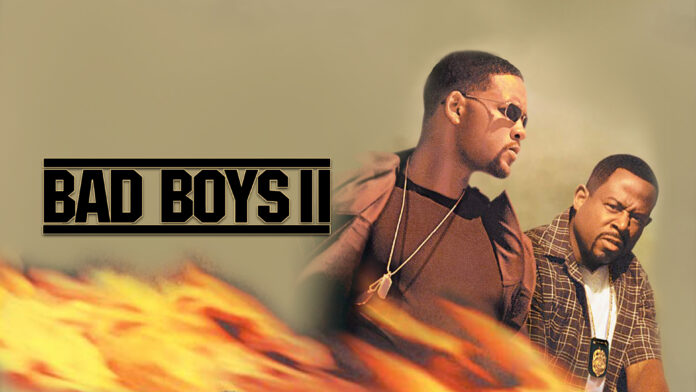Introduction
Released in 2003, Bad Boys II—directed by Michael Bay and starring Will Smith and Martin Lawrence—remains a polarizing yet iconic entry in the action-comedy genre. Serving as the sequel to 1995’s Bad Boys, the film follows Miami narcotics detectives Mike Lowrey (Smith) and Marcus Burnett (Lawrence) as they confront a Cuban drug lord, Johnny Tapia (Jordi Mollà), while navigating personal tensions and ethical dilemmas. Despite its box office success ($273 million globally) and cult following, the film has drawn sharp criticism for its gratuitous violence, racial stereotypes, and glorification of police misconduct 21014. This article explores the film’s cinematic style, cultural resonance, and enduring controversies, offering a comprehensive analysis of its legacy.
1. Cinematic Style and Michael Bay’s Signature Excess
Michael Bay’s direction in Bad Boys II epitomizes his trademark “Bayhem”: hyperkinetic editing, saturated visuals, and relentless action sequences. The film’s 146-minute runtime is packed with explosions, car chases, and shootouts, including a notorious highway pursuit where cars are flung from a transport truck, captured in dizzying, camera-mounted perspectives 1113. Bay’s rapid-fire editing and disorienting angles—such as a revolving shot during a shootout in Tapia’s mansion—prioritize sensory overload over narrative coherence. Critics argue this style reflects a post-9/11 American mindset, where chaos and militarized force dominate 13. While fans praise the film’s audacious energy, others condemn its “soulless brutality” and lack of spatial logic, exemplified by a Hummer inexplicably escaping a pond mid-chase 116.
2. Plot and Character Dynamics: Loyalty vs. Lawlessness
The plot centers on Mike and Marcus’ investigation into Tapia’s ecstasy-smuggling ring, which intersects with DEA agent Syd Burnett’s (Gabrielle Union) undercover work. Personal conflicts drive the narrative: Marcus contemplates leaving the force after Mike accidentally shoots him, while Mike secretly dates Syd, Marcus’ sister 24. The duo’s chemistry—a mix of bickering and loyalty—anchors the film, though their actions often cross ethical lines. For instance, they intimidate Marcus’ daughter’s date with threats of violence and homophobic slurs, a scene criticized for its cruelty 110. Their disregard for protocol—illegal wiretaps, property destruction, and civilian casualties—frames them as “anti-heroic” figures, blurring the line between justice and vigilantism 1416.
3. Cultural and Social Commentary: Race, Power, and Post-9/11 America
Bad Boys II’s portrayal of Black masculinity in law enforcement is groundbreaking yet problematic. As two Black leads in a buddy-cop franchise, Smith and Lawrence challenge Hollywood’s historical preference for white protagonists. However, the film’s celebration of police brutality and racial stereotypes—such as Haitian “pirates” and Russian mobsters—has drawn backlash 714. The movie’s release two years after 9/11 also reflects a broader cultural shift toward militarized policing and xenophobia. For example, the finale at Guantanamo Bay, where the heroes battle Tapia in a minefield, symbolically reinforces American exceptionalism 1314. Meanwhile, the film’s depiction of drug use—glamorizing rave culture while condemning dealers—echoes conservative narratives that justify authoritarianism 14.
4. Controversial Scenes and Ethical Questions
Several sequences in Bad Boys II have sparked debate. The shantytown destruction scene, where the protagonists plow through a Cuban hillside village in a Hummer, ignores civilian casualties, reducing poverty-stricken residents to collateral damage 113. Similarly, Marcus’ ecstasy-induced rampage—played for laughs—trivializes drug harm, despite a later nod to its dangers 1016. Critics argue such moments reveal the film’s moral bankruptcy, prioritizing spectacle over empathy 110. Even the climactic raid on Tapia’s compound, inspired by Jackie Chan’s Police Story, underscores Bay’s penchant for repurposing foreign cinema into American propaganda 13.
5. Legacy and Influence: From Cult Classic to Cultural Critique
Despite mixed reviews, Bad Boys II cemented its place in action cinema history, influencing later franchises like Fast & Furious. Its success paved the way for sequels Bad Boys for Life (2020) and Bad Boys: Ride or Die (2024) 27. However, the film’s legacy is fraught. While some view it as a transformative work for Black representation, others see it as normalizing police misconduct and racial profiling 714. The “bad boys” ethos—rule-breaking cops justified by their targets’ villainy—resonates uncomfortably in today’s climate of police accountability movements 14.
Conclusion
Bad Boys II is a study in contrasts: a technically proficient action spectacle that revels in excess while grappling with unintended cultural implications. Its over-the-top style and flawed protagonists captivate audiences, yet its ethical ambiguities and dated stereotypes invite scrutiny. As debates about policing and representation evolve, the film serves as both a time capsule of early-2000s cinema and a cautionary tale about the consequences of glorifying lawlessness. Whether celebrated as a guilty pleasure or critiqued as a problematic artifact, Bad Boys II remains a defining work in Michael Bay’s filmography.
Frequently Asked Questions (FAQs)
1. Why is Bad Boys II considered controversial?
The film faces criticism for its graphic violence, homophobic humor, and portrayal of police brutality. Scenes like Marcus intimidating his daughter’s date and the destruction of a Cuban shantytown highlight ethical lapses 11013.
2. How does Bad Boys II handle race and representation?
While groundbreaking for centering Black leads in a buddy-cop dynamic, the film perpetuates stereotypes of Haitian gangs and Latino drug lords, reinforcing xenophobic narratives 714.
3. What is the significance of Marcus’ ecstasy scene?
The scene blends comedy and critique, showcasing Martin Lawrence’s physical humor but trivializing the dangers of drug use. Critics argue it undermines the film’s anti-drug message 1016.
4. How does the film reflect post-9/11 America?
Its militarized action and Guantanamo Bay finale mirror post-9/11 anxieties, endorsing a “ends justify the means” approach to law enforcement 1314.
5. Is Bad Boys II worth watching despite its flaws?
Fans of hyper-stylized action may enjoy its spectacle, but viewers seeking nuanced storytelling or ethical coherence may find it lacking 1116.
For further analysis, explore the sources cited in this article or revisit the film with a critical lens.

